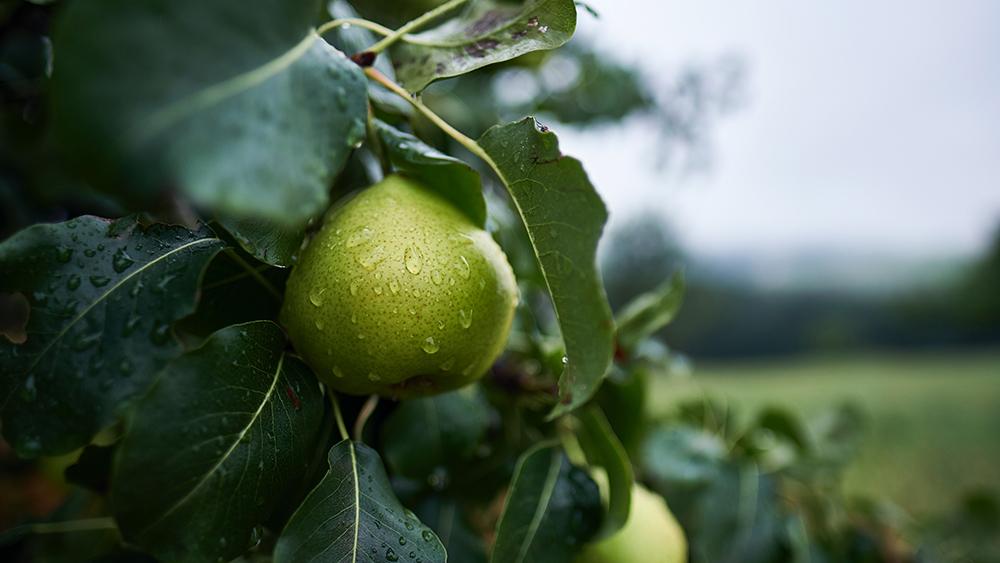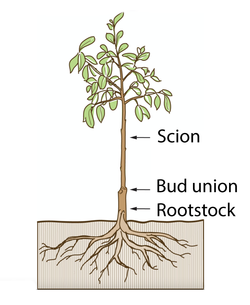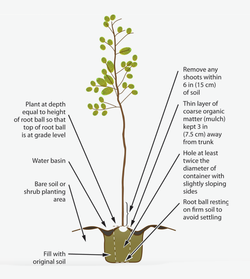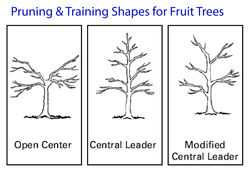PRUNING TIPS for specific fruit trees
Below are pruning tips and advice for fruit trees and plants commonly grown in Marin. Click to learn more!


> Special Considerations for Pruning Fruit Trees
> How to Prune New Fruit Trees
> Pruning Tip Sheets for Specific Fruit Trees
> Cultural Tips for Specific Fruit Trees
Fruit trees merit their own special section on pruning because:
Fruit tree pruning focuses on fruit production
Pruning focuses on techniques that maximize fruit production, not the aesthetic beauty of the plant.
Every fruit tree is different
Almost every type of fruit tree requires a different type of pruning. It is essential to know the pruning needs of each type.
Fruit is heavy - weak branches need removing
Pruning removes weak branches to help ensure that the fruit will not bend or break the branches. Fruit is heavy, even when thinned in the early summer. While heading cuts are generally discouraged on most ornamental trees and shrubs, they are useful for properly shaping a fruit tree.
Fruit trees benefit from pruning TWICE each year
Once in the dormant season (usually winter, but not always!) and once again in the summer - but please check the specific pruning sheets for your tree, as apricot and cherry trees are not pruned in winter.
Why prune in the summer?
Summer pruning may seem counterintuitive, because removing branches and leaves reduces the total amount of photosynthesis that the plant can perform. This not only slows plant growth during the remainder of the growing season, but also reduces the amount of sugar that the plant otherwise would have stored in its root system during the dormant season to fuel its growth in the early spring. Yet, summer pruning of fruit trees is desirable for several reasons:


What this means is that the roots and the tops (called the “scion”) come from different trees. This allows the joining of a strong and disease-resistant rootstock to a scion that produces abundant fruit of high quality. It is critical to know about grafting, because suckers and branches that grow from the rootstock will not produce desirable fruit (if at all). Suckers growing from the rootstock and from below the graft should be removed and, preferably, torn off when very young to avoid leaving a small stub from which other suckers and branches could emerge.
Nearly all fruit trees must meet certain "chill" hour requirements
All fruit trees (except citrus) require a specified number of “chill” hours (hours when the temperature is under 45° Fahrenheit) during the dormant season. The chill hours requirement is necessary for these trees to leaf out at the proper time in the early spring, set their fruiting buds, and produce abundant fruit. If a fruit tree is planted in a location that will not be cold enough to provide the needed chill hours that the plant requires, no amount of pruning will correct this.
First, make sure you plant the tree correctly

• Dig a wide hole and one that is no deeper than is necessary to cover the roots plus about half the distance between the root crown and the graft – not up to the point of the graft. The graft is the knob where the root stock joins the upper portion of the plant (scion). It is often five to eight inches above the root crown. Digging a deeper hole risks settling of the soil and creating a bowl into which the plant will settle.
• Trim any broken roots.
• To avoid sunburn on the graft, point the outward protruding portion South.
• Fill the hole with native, unamended soil. Press the soil down, but not too firmly.
Container trees
• If the nursery has very recently transplanted the plant into a pot, move the tree from the pot and plant as above.
• If the tree has been in a container long enough to leaf out and spread its roots, plant in warmer weather, e.g., in June.
• Dig a hole twice as wide as, and no deeper than, the container. Gently remove the tree from the container. Do not pull it straight up. It may be necessary to lay the container on its side and cut between the sides of the container and the soil around the root ball.
• Set the plant in the hole, making sure the soil around the tree's root crown is level with surrounding earth's soil.
• Surround the root ball with native, unamended soil, adding a thin layer over the root ball.
Make the FIRST CUT on the newly planted tree
• The initial cut on a young bare root tree is the most important in the life of the plant. Most gardeners cannot bring themselves to take this critical first step, but this is an essential thing to do.
• Use a heading cut to shorten the trunk to no more than 24 to 30 inches from the ground level.
• Cut at a 45-degree angle about one-quarter of an inch above the bud chosen to be the top bud. Several buds should remain below the cut.
• Shorten remaining branches - If there are any remaining branches, shorten them to three to four buds.
• Make sure that the bud closest to the cut faces upward (if the branch has a broad angle) or outward (if the branch has a shallow angle).
Notable Exceptions to the First Cut Procedure:
• Persimmon
Persimmon can be pruned at the outset as described above, if the goal is to grow the tree for its fruit and to keep it small. However, persimmon can be allowed to grow as a tall landscape tree as long as the gardener prunes it to ensure strong scaffold branches throughout to hold the heavy fruit.
• Pomegranate
Pomegranates are cane plants. They can be allowed to grow as a dense thicket (but with diminished fruiting in the center), as an open multi-stemmed plant, or as a small single-trunk or multi-trunk tree. All of these pruning techniques will produce abundant fruit, but the appearance of the plant will vary greatly.
• Weeping plum
Weeping plums (e.g., ‘Santa Rosa’ plum) can be pruned at the outset as described above, if the goal is to grow the tree for its fruit. Unpruned, it will grow as a landscape tree into a mounding form that can be thinned each year.
• Multi-graft trees
Prune only the tips of the branches of young multi-graft trees in the summer. If the tree is cut down to 24 to 30 inches at the outset, there is a risk of removing all of the grafted material.
Establishing SCAFFOLD BRANCHES
Starting with the first spring, it is important to begin to establish the scaffold or main branches of the tree. This is not a difficult process, but it requires attention to detail. Consult the “Additional Resources” section below, which includes step-by-step instructions on how to prune young fruit trees during their first three years.
Establishing a CENTRAL LEADER or VASE-SHAPE/OPEN CENTER 
................................
Below are pruning tips and advice for fruit trees and plants commonly grown in Marin. Click to learn more!
Grapes
Some gardeners feel that pruning grapes is a task for professionals only. However, there are many excellent articles, books and videos that explain basic techniques that home gardeners can easily follow. Below are some of those resources for pruning grapes:
Training and Pruning Grapes (UCANR)
Grapes: Cultural Tips (UCANR)
Additional resources for the average home gardener on how to grow and prune new and established fruit trees include the following:
Fruit Trees: Training and Pruning Deciduous Trees,
C. Ingels, P. Geisel (UCANR, Publication 8057, 2002)
Fruit Trees for Every Garden
O. Martin, M. Martin (Ten Speed Press, 2019)
Grow a Little Fruit Tree
A. Ralph (Storey Publishing, 2014)
How to Prune Fruit Trees
R. Sanford Martin (Echo Point Books & Media, 2013)